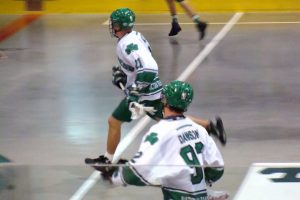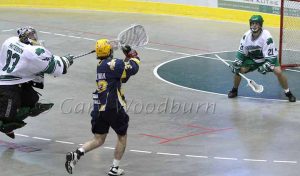
Fundamental Skills Analysis:
Transition
- Slow Break (See Transition Drill #3C): A transition scenario where no fast-break is available and equal numbers of players are present on both teams. Starting with the goalie, teams have 5 seconds to move the ball out of their "crease" once they obtain possession, with 3-5 potential passing “outlets” generally available to the goalie (see “Standard Breakout”). Teams should keep the ball away from the bench while making a “line change” and have defenders run the ball up the floor in “pairs,” so they do not get swarmed or “double-teamed” without having an outlet to pass to ("take care of the ball").
- Fast Break (See Transition Drill #8A): Players should always be looking for odd-player or “fast-break” opportunities, whereby their team has a numerical advantage in players while transitioning from defense to offense. Break “4-on-3’s” down into “3-on-2’s,” then 2-on-1’s, by always being a threat to run uncontested to the net; if nobody pressures the ball, shoot! High risk passes should generally be avoided, as quality shots are a must in this situation.
Players should anticipate the other team about to pressure the ball (slide) as they approach the prime scoring area then simply pass to the next open player. Eventually, this odd player situation will get broken down into a single player open “in tight,” or on a “breakaway.”
Should a fast-break already be in progress, a fourth or fifth player need not “join the rush” to make a 3-on-2, a 4-on-2, for instance; instead staying back near half-floor to guard against “reverse transition” or to pick up a loose ball. If a "fast-break" turns into a slow-break (even-strength), the last option is always to try for a pick & roll on the strong-side, whether it be on-ball or off-ball.
- Running the Floor (See Transition Drill #0): Players should run in their "Lanes," 2 outside and 2 inside, staying spaced far enough apart that one defender cannot cover two players; always aware of where the ball is. The goal of the two players in the outside lanes should be to run as fast as possible on a 45° angle towards the same-side goal-post.
The trailers in transition may sometimes also have to "slow-up," to maintain adequate “spacing.” Try to get the ball to the middle of the floor, where possible, which generally opens up a lot more options.
Ideally players will all be on their “proper floor side;” try to make this happen as best as possible. If two players are on a 2-on-1 and “same-handed” in terms of right or left, getting the ball to the middle is vitally important.
- Breakaways (See Goaltending Drill #4A): Always run full speed on a breakaway, also while practicing breakaways. Make sure to take a “banana curl” towards the net if the opportunity is there (i.e. moving gradually across the front of the net as the ball carrier approaches; in the shape of a banana). Players should also take a look behind them (if possible) recognizing whether it is a “partial breakaway” where the ball must be protected, or not.
- Defending Transition (See Transition Drill #8A): Getting back on defense is not an option; offensive players need to be aware and run hard to cover against "reverse transition," which is the very first commitment to team defense. If a fast-break is in progress, the last player back from that team needs to stay on the floor to guard against any “reverse transition” opportunities.
4-on-3’s should be defended using a one up, two back “triangle.” 3-on-2’s should be defended using the “I-Formation,” and 2-on-1’s by “splitting” the 2 players and communicating with the goalie on whether to pressure the shooter or take the off-ball player (“take inventory”). Be aware of getting picked at the end of unsuccessful fast breaks against.
- Decision Making (See Transition Drill #8C): As players approach the net during a fast-break, defenders will "take inventory" and eventually slide over and pressure the most dangerous player with the ball. Defenders should always have their sticks up in these situations and are encouraged to “finish (body check) their checks,” in order to intimidate the other team.
Players on their “wrong side” in transition are much less of a threat and should be encouraged to shoot, defensively; otherwise it’s usually best to force an opponent to make consecutive passes in a row via multiple slides, if possible.
- Categories: Beginner / Free / Drillbook / Transition


